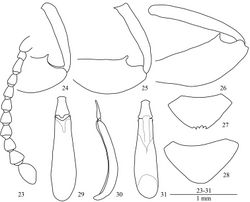Laena chiloriluxa
| Notice: | This page is derived from the original publication listed below, whose author(s) should always be credited. Further contributors may edit and improve the content of this page and, consequently, need to be credited as well (see page history). Any assessment of factual correctness requires a careful review of the original article as well as of subsequent contributions.
If you are uncertain whether your planned contribution is correct or not, we suggest that you use the associated discussion page instead of editing the page directly. This page should be cited as follows (rationale):
Citation formats to copy and paste
BibTeX: @article{Xiao-Lin2012ZooKeys177, RIS/ Endnote: TY - JOUR Wikipedia/ Citizendium: <ref name="Xiao-Lin2012ZooKeys177">{{Citation See also the citation download page at the journal. |
Ordo: Coleoptera
Familia: Tenebrionidae
Genus: Laena
Name
Laena chiloriluxa Xiao-Lin & Guo-Dong, 2012 sp. n. – Wikispecies link – ZooBank link – Pensoft Profile
Type material
Holotype ♂ (MHBU): China, Yunnan Province, Bababhe. N. R. Bengganghan, 1930 m, 14 November 2008, J. Y. Hu & L. Tang leg.
Paratype: 1♂ (SMNS): labelled as the holotype; 1♀ (SMNS), 1♀(MHBU): China, Yunnan, Bababhe, Dianshita, 1900 m, 30 June 2005, LI & LI leg; 1♀ (MHUB): China, Yunnan, Bababhe. N. R. Bengganghan [22.25833° N, 100.66361° E], 1700 m, 14 November 2008, J. Y. Hu & L. Tang leg.
Etymology
Named after the green metallic shine of the body.
Diagnosis
The new species is similar to Laena luguica Schawaller, 2001, but can be easily distinguished from it by the following characters: (1) all tibiae of male with finely hooked inner apex, especially the middle tibiae; (2) last abdominal ventrite of male denticulate at apex; (3) the shape of the aedeagus is different.
Description
Male. Dorsal side with green metallic shine. Eyes (Fig. 3) elliptical, moderately prominent. Antennae (Fig. 23) extending to base of pronotum, ratio of length (width) of antennomeres II–XI as follows: 5.3 (6.0): 13.3 (6.3): 10.0 (6.7): 10.3 (6.8): 10.1 (7.8): 10.2 (8.1): 10.8 (8.5): 10.0 (8.8): 12.0 (11.5): 18.3 (11.5).
Pronotum (Fig. 3) cordiform, basal margin distinctly narrower than anterior margin, 1.2 times as wide as long, widest just behind anterior margin; disc with small punctures, punctures medially somewhat sparser than laterally, their distance 2–6 times as long as puncture diameter, most punctures with long and erect setae, surface flat and shining, lateral margins bordered, basal margin bordered, feebly in middle, not bent downwards, posterior angles rounded; propleura with smaller punctures and shorter setae than those of disc.
Elytra (Fig. 3) oblong, 2.1 times as long as wide, widest at middle; punctural rows placed in indistinct striae, punctures distinctly larger than those of pronotum and each bearing a long and erect seta, intervals with regular row of small punctures each bearing a similar seta, all intervals flat and shining, interval IX with 5 setiferous umbilicate pores, interval VII in both humeral and posterior region with a setiferous pore.
All femora (Figs. 24–26) each with a strong tooth. All tibiae (Figs. 24–26) with finely hooked inner apex, especially on middle tibiae.
Last abdominal ventrite (Fig. 27) denticulate at apex. Aedeagus see Figs. 29–31.
Female: Dorsal side without green metallic shine. Last abdominal ventrite (Fig. 28) sharp at apex, not denticulate.
Body length: 6.2–7.2 mm.
Original Description
- Xiao-Lin, Z; Guo-Dong, R; 2012: Six new species of the genus Laena Dejean from China (Coleoptera, Tenebrionidae, Lagriinae) ZooKeys, 177: 15-36. doi
Images
|

